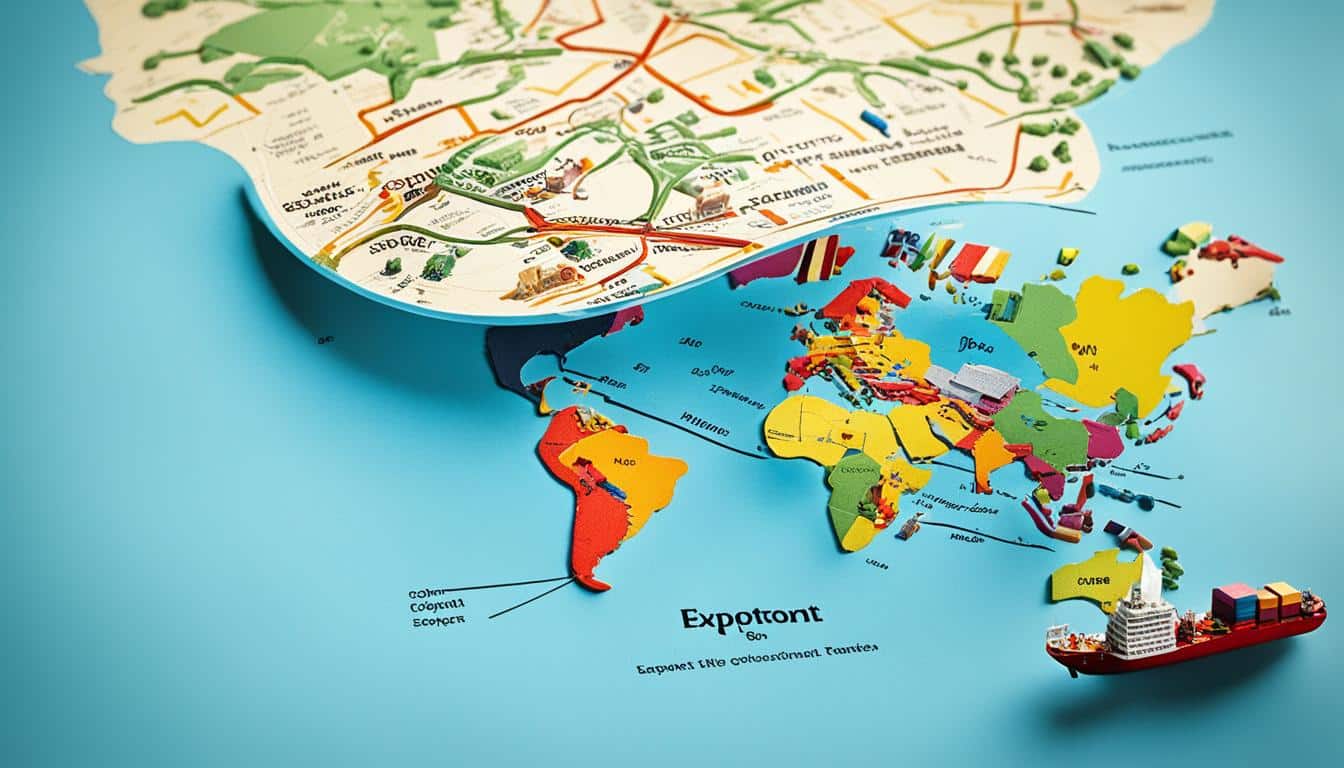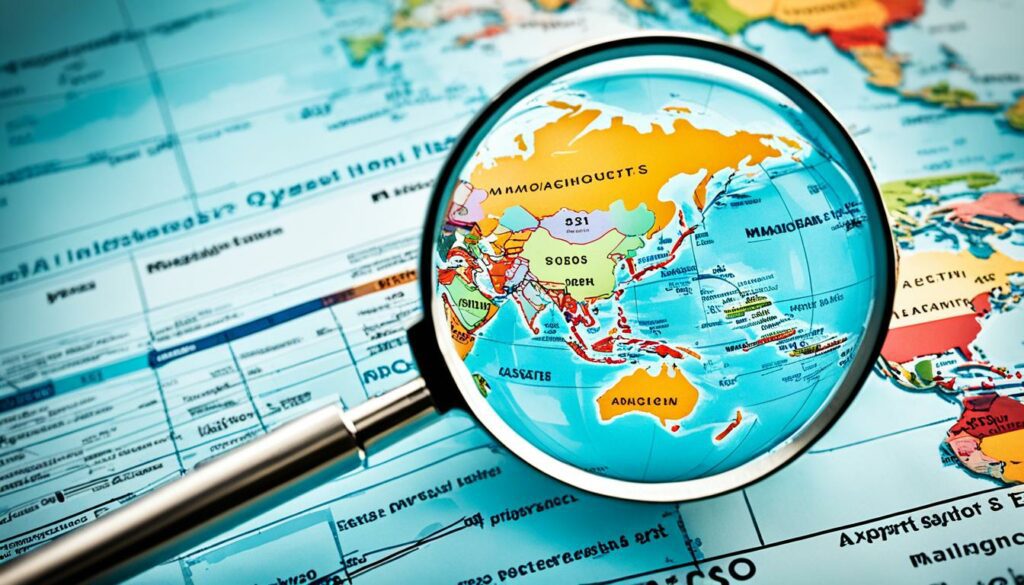Menu

Over 70% of businesses that expand into new export markets grow significantly in three years. The world economy is tightly linked. Moving into new markets is vital for companies wanting steady growth. It involves finding new countries to sell to, using technology to find these markets, selling online, and running your product supply well. These steps bring many chances while reducing the risk of depending too much on one market. In today’s changing global market, diversifying is not just a plan; it’s key to stay in business and thrive.
Export market diversification is key in dealing with the risks of focusing too much on one market. It helps ensure that economic growth is steady and not too vulnerable to big changes. By selling products to different places, a business can stay strong even when one market slows down.
Relying heavily on one market can be risky. If that market slows down, it can cause big economic problems. Countries such as Laos and Myanmar faced unstable earnings between 2009 and 2019 because of this. In contrast, Thailand, with its wider range of export partners and products, had a more consistent income during the same period.
Having a mix of export destinations and products can make an economy less prone to these sudden shocks. It provides a more solid foundation for economic growth.
Diverse export markets help economies withstand tough times and grow sustainably. Asian developing economies, like those in ASEAN, showed this during the 2007-2008 financial crisis and the recent COVID-19 outbreak. They managed to keep their export losses lower than regions like Africa and Latin America in 2020.
For example, Southeast Asia’s export spread has been more balanced than in China. This balance made it easier for Southeast Asian countries to weather economic storms.
Looking at countries that successfully broaden their export base gives us good tips. Vietnam’s growth in exporting various products and to many places has made its economy more stable. This is because the country didn’t rely too much on just a few markets.
Similarly, India’s export strategy to hundreds of trading partners across different industries shows huge success. It proves that selling to more places with diverse products can make an economy stronger. This strategy helps avoid a heavy reliance on a few markets.
Research and examples point to the importance of export market diversification for businesses. It’s crucial to not put all the eggs in one basket. This strategy is a key player in ensuring economic strength and long-term growth. For success in global trade, diversification should be a central strategy for every business.
Conducting thorough market research is key to finding and assessing export chances. With e-commerce’s growth, businesses can now reach new, global markets easily. The main steps are studying the export market, analysing what consumers prefer, and checking out the competition.
To do export market research right, try using online tools. These include databases, market analysis sites, and software for looking at detailed data. Using these can show you what your potential customers like. It helps make sure your products fit what they want and need. For example, data analytics can spot trends in different places, helping you customise your products for those markets.

It’s also vital to look at what your competition is doing. Studying your rivals’ strategies and positions can help you find a unique spot in the market. Learning from both successes and mistakes of others can give you a strong plan. You can mix the best strategies from different companies to suit your own situation.
Research shows that making smart decisions is crucial. Articles like “Navigating Export Market Diversification Strategies” and “Unveiling the Art of Crafting an Effective Export Pricing Strategy” stress this on specific dates. They illustrate how using the latest tech in supply chain and logistics is key.
To sum up, technology is very important in export market research. It helps in understanding what consumers want and how the market looks. By using digital tools and keeping up with trends, businesses can be ready to enter a new market.
Creating a great market entry plan is key to success in new global markets. It involves dealing with hurdles, following rules, and making a detailed plan. This way, companies can start strong, expand well, and sustain their growth.
The first big step in a market entry plan is spotting hurdles like tariffs and competition. It includes looking closely at limits such as tariffs and quotas. Knowing these challenges helps businesses plan how to avoid or work around them.
By doing this early, companies lower their risks and get ready for market entry better. They might choose different paths or seek local help to tackle these issues.
Sticking to laws and standards is very important when entering a new market. Companies need to follow the market’s rules about product safety and other laws. This keeps them out of legal trouble and earns the trust of their customers.
Focusing on regulatory compliance makes the market entry smoother and more effective. It is a big part of a successful plan for entering new markets.
Having a clear timeline for market entry keeps everything moving well. It shows the steps from doing market research to the product launch. A clear plan helps keep everyone on the same page and deal with problems fast.
This strategic timeline method helps businesses enter new markets step by step. It boosts their chances of doing well in these new areas.
A full market entry plan includes tackling trade limits, following rules, and a detailed timetable. It lays a strong base for moving into international markets the right way. This approach cuts down on risks and boosts the chance of big success in new markets. To learn more about these strategies, check out the International Trade Council’s advice on how to diversify export markets at https://tradecouncil.org/export-market-diversification.
Working with local partners is key when heading into new export places. Partnerships with local vendors or through joint ventures are crucial. They bring essential tips that can help a company get into a new market and run better.

It’s vital to find trustworthy local distributors. They know what local consumers like and understand the market well. Businesses should take care in choosing the right partners, making sure they share the same goals.
Joining with local businesses or starting alliances can be very beneficial. It combines the best of both worlds. According to Raxer Toledo, this strategy can give companies important market knowledge and better network access, helping with customer outreach and entering markets smoothly.
In the end, these kinds of partnerships really help businesses succeed in new markets. Bringing in local knowledge and working together with other companies can strengthen a business. This sets the stage for continuous growth in different areas.
Expanding into new export markets can make a business more stable and offer chances for growth. To succeed, products and services need to be tailored to local tastes, laws, and economic situations. This means changing what a product does, the way it looks, and how much it costs. Each change is important for success in a new place.
Adapting a product means making it fit what people in a certain area like. This is key to making the product stand out and do well against rivals. It also helps a company get a stronger position in the local market.
Changing the look and info on a product’s package is vital for getting local people interested. It might include translating labels, using images that are meaningful in that culture, and following local rules. These tweaks make the product more attractive and help it meet legal standards.
Setting the right price is critical for how well a product sells. Businesses must understand what their competition is doing and what customers want. This knowledge helps set prices that get the most sales without losing money.
| Key Aspect | Action | Outcome |
|---|---|---|
| Customising Products | Align product features with local preferences | Enhanced market relevance and appeal |
| Localising Packaging and Labelling | Translate labels, culturally adapt images, comply with local laws | Increased consumer trust and regulatory compliance |
| Pricing Strategies | Adjust prices based on market research | Improved market penetration and revenue |
Raxer Toledo wrote an insightful piece on May 10, 2024, about creating effective export prices. He shared tips on how businesses can grow and do well by keeping a close eye on market changes. This approach can lead to them doing better in new places over time.
Today, reaching a big global market means using digital channels. Business must not overlook these opportunities. Digital tools and internet platforms help grow an online presence worldwide. They also make websites friendly for all, and social media aids in engaging with people globally.

Having a presence online worldwide is key for companies that want to reach everywhere. Platforms such as Amazon, Alibaba, and eBay have changed how companies connect with people globally. This broadens the view of their products to a larger set of consumers.
Analysing big data helps find the best places to sell overseas. Understanding what customers want and what’s happening in the market guides decisions. This leads companies to find new, profitable markets to explore.
Your website needs to attract and keep visitors from around the world. This means making it faster and easier to use. Also, using SEO methods that meet local needs. Focusing on regional search preferences and cultural aspects helps businesses connect better with other markets.
Localising website content is also important. It means translating and adapting the content to fit local cultures. This makes visitors feel more welcome and understood when they visit the site.
Social media is essential for growing your digital presence. Platforms like LinkedIn, Instagram, and WeChat are great for interacting globally. With targeted ads and campaigns, companies can focus on specific groups, making their messages more effective.
By posting interesting content and talking to their audience online, businesses can become more well-known. This also helps in building a loyal customer base. Using SEO and ads on social media alongside these efforts, powerful campaigns can be created.
| Tools/Platforms | Benefits |
|---|---|
| Amazon, Alibaba, eBay | Global reach, enhanced visibility |
| Market Intelligence Platforms | Informed decision-making, identifying export opportunities |
| SEO & Website Optimisation | Improved user experience, better search rankings |
| Social Media Marketing | Targeted engagement, increased brand awareness |
| Communication Tools | Seamless partnership connections worldwide |
| Cybersecurity Measures | Data security, compliance with regulations |
| Online Courses & Webinars | Continual learning, adaptive strategies |
Participating in trade shows and international exhibitions can be great for businesses. It allows them to meet new people, get new leads and get known in new places.
At such events, companies can show off their products to people from all over the world. This helps them get feedback and learn things that can help them plan for the future.
Getting ready before the show starts is key. It’s important to know what you want and who you want to meet. This way, you make the most of your time and efforts.
Making your booth interesting is also vital. Things like interactive displays can draw people in and help you get more leads. A great booth can make your company stand out.
But, the work doesn’t stop when the show ends. Following up with the leads you got is crucial. It solidifies your new connections and may turn them into long-lasting business deals.
| Benefits | Strategies |
|---|---|
| Networking Opportunities | Participate in seminars and matchmaking sessions |
| Showcasing Products | Create engaging booth experiences |
| Market Research | Gather direct market feedback |
| Follow-Up | Convert leads into customers through timely follow-up |
In summary, taking part in international exhibitions and business networking events can help businesses grow worldwide. It boosts their visibility, gives them new insights, and expands their network, driving success.
Exporting is not just about avoiding risks. It’s also about making the most of chances for growth and efficiency. China is key here, as it made up a big part of global exports in 2020. It is important to see how its high numbers affect the world’s supply chains.
Technology is vital for making supply chains work better. Tools like ERP software and IoT devices let us see into every step of the supply chain. This helps make sure exported goods reach their destination on time.
The Covid-19 crisis made freight shipping take longer. To tackle this, using smart technology in managing supply chains can help a lot. For example, blockchain can make exporting simpler and cheaper by adding transparency.

China also plays a huge role in pharmaceutical exports. It provides most of the U.S.’s active pharmaceutical ingredients (APIs). This shows how vital good inventory management is to avoid shortages.
Geopolitical and logistical issues are pushing the U.S. to diversify its supply chains. It has put tariffs on many Chinese imports. So, businesses are looking for new suppliers in places like Japan’s recent investments.
Companies need to mix technology with smart planning for their supply chains. Doing this not only makes things move smoother but also boosts profits. It keeps their business growing internationally.
International trade is growing fast, making it important to protect important data. To move lots of data easily, we need strong security measures in place. This includes using tough cybersecurity, following privacy laws, and keeping export documents safe. These steps help businesses keep their reputation and the trust of their customers.
Using the latest tech in trade makes things run better but also opens the door to cyber-attacks. A study found that companies using technology in their supply chain saw better control over their stock. Yet, they must make sure their data is safe by using encryption and secure digital storage.
It’s very important for businesses trading internationally to meet all data protection laws. Each place has its own rules, which can be tricky. Technology can help companies follow these rules correctly, keeping data safe and customers happy. Teaching employees about these laws is also key to data security.
Keeping export papers safe is crucial in global trade. A mistake here could lead to leaks or legal problems. Businesses can use digital storage for these documents and must do regular checks and keep detailed records. Also, making sure contracts are clear can help keep trading smooth and secure.
In the fast-moving world of global trade, setting up and keeping up with communication is vital. This helps you get past language hurdles, boosts technology’s role in talking business, and keeps your relationships strong worldwide.

Dealing with different languages is key for doing well in global business. Having staff who speak various languages, using translation services, and providing cultural training all help a lot. Tools like AI for translations and language apps also make a big difference. They make sure everyone understands each other clearly.
Technology has changed how companies talk across the globe. Platforms like Zoom and Teams make video calls easy. Apps like Slack help with quick messages. These tech tools allow for instant contact, which makes managing global trade simpler. They also help in building stronger ties with partners internationally.
To keep your partnerships strong, you need to talk clearly and often. Good communication systems let businesses connect easily with their partners. They help solve problems fast and build trust. Using the best technology not only makes talking simpler but also makes relationships stronger. Regular video calls and quick feedback keep the conversation flowing and fruitful. This way, international business gets a big boost.
In today’s world, e-commerce lets exporters reach out to the whole planet. They can use big platforms like Amazon, Alibaba, and eBay easily. This way, they get to share their products with customers globally. And they get help with safe online payments and shipping.
Technology helps keep track of products moving along the supply chain. It makes sure items are in stock and delivered on time. This is very important for businesses that want to grow online. Also, online talks and messages make it easy to work with people from around the world.
Using the internet for marketing with SEO and social media is also key. It lets companies aim their ads at people around the world. This boosts their online sales a lot. Technology also keeps data safe and helps follow export laws. This means less chance of trouble and more secure international business.
It’s important for companies to keep learning online. This way, they can keep up with the latest trends and good ideas. These lessons and talks can help them do better at growing their online presence. We’ve put together a chart to show how different online tools help with selling worldwide:
| Aspect | Contribution to Export Strategies |
|---|---|
| E-commerce Platforms | Connects businesses with global audiences, simplifies export process |
| Supply Chain Management | Provides real-time visibility, efficient inventory management, timely delivery |
| Communication Tools | Facilitates seamless global communication and collaboration |
| Digital Marketing Tools | Enables targeted campaigns, reaching international audiences |
| Data Security Technologies | Ensures compliance with export regulations, reduces risk of penalties |
| Continuous Learning Resources | Helps adapt to global trends and best practices in export strategies |
In today’s fast-evolving trade world, it’s key for companies to always keep learning about continuous learning in export. They also need to stay agile. Knowing how international markets change and getting good at global trade strategies help a lot.
It’s very important to keep up with what’s happening in the global market. This means watching economic signs, new tech, and how people’s buying habits change. For instance, big e-commerce sites like Amazon and Alibaba make up a big share of worldwide online sales.
They affect how companies should sell things and reach customers. By using this kind of information, companies can plan how to enter markets smartly.
It’s essential that the team keeps getting better at skill development for international trade. Learning continuously online and in industry events can make exporting more efficient by 15%. This includes mastering new market tools and digital marketing.
It also involves learning about international rules, making a company more competitive.
Listening to market feedback is crucial in making export plans better. Feedback from many places, gathered online or in meetings, gives deep insights. It helps in making smarter decisions.
This way of learning from feedback improves how quickly a business responds to market needs. It also boosts customer happiness.

The facts back up these moves. Companies that sell to different markets make 20% more money than others. So, making a promise to learn and adjust is a sure way to do well in global trade.
| Key Activity | Impact |
|---|---|
| Utilising Technology for Market Research | 70% of businesses make informed decisions |
| Implementing Digital Marketing | 30% increase in international sales |
| Effective Communication Platforms | 40% improvement in partner collaboration |
| Technology-Driven Supply Chain Management | 25% reduction in logistics costs |
Exporting to different countries can be very good for business. It helps them have more stability and chances to grow.
One big benefit is advantages of market diversification. It lets companies sell to more people by going into new markets. Take Chile, for example. It started selling more than just copper. Now, it sells vehicles, pharmaceuticals, and more. This move helped them find new customers even though copper was their main export product.
It’s also great for avoiding risks in one market. If companies sell in different markets, they’re not as affected by just one place’s problems. Mauritius learned this lesson by selling more than just sugar and textiles. In 2010, these two items made up almost all their exports. Diversifying helped them not rely so heavily on those two types of goods.
Exporting to different places opens new doors for companies. As countries make more money, they buy and sell different things. So, selling a variety of goods becomes more important. A study of 201 countries showed that having good governance and education can help a lot. These factors make it easier to trade and find new markets.
| Region | Herfindahl Index (1970) | Herfindahl Index (2000) |
|---|---|---|
| South America | 0.354 | 0.204 |
| North America | 0.073 | 0.07 |
| European Union | 0.076 | 0.063 |
| East Asia | 0.151 | 0.108 |
| Africa | 0.268 | 0.20 |
| Other countries | 0.365 | 0.092 |
Looking at these benefits, it’s clear diversifying markets is a smart move. It helps businesses grow in a sustainable way. Companies get to reach more customers, avoid big risks, and find new opportunities.

Starting in a new market can be tough without proper preparation. Some hurdles include getting past entry barriers, dealing with cultural differences, and handling economic and political risks. To overcome these, businesses need to know these challenges well and use smart solutions.
Different places have different hurdles for businesses to start. These can be rules, taxes, or needing local approvals. For instance, Canada makes it easier with trade deals and support for exports. This includes 14 agreements and help for small and medium businesses through the CanExport program.
To do well abroad, it’s vital to understand and adapt to local cultures. This means knowing how people live, what they buy, and changing your products and how you sell them. Agreements like the CPTPP help Canadian businesses by opening up markets in 11 countries, giving them special access. This way, businesses can more easily meet the local needs of different cultures.
Working in new countries also means facing financial and political risks. Nearly half of world trade is in developing countries, and many poor people live there. To deal with these risks, businesses need to do a lot of research and have strong plans. Offers like Faststart Capital’s 50% cost coverage for certain services help reduce the risks for businesses.
Export market diversification is key for companies looking to strengthen their global influence. It helps them avoid relying too much on one market. This way, they can withstand changes in the economy better and grow more steadily. Take Mauritius for example. It shifted its main export from cane sugar in 1980 to more varied products by 2010. In 1980, cane sugar made up almost 69% of its exports. By 2010, services were at 52.63%.
Mauritius’s journey over 30 years clearly shows the benefits of varied exports. Even though sectors like textiles saw less growth, they were still important. But there was a big rise in the transportation sector’s exports. This change is proof that adapting to global change is crucial. After studying 156 countries, it’s clear that mixing up exports helps economies grow.
There’s also strong evidence from Latin American countries on this. Between the mid-1960s and late 1990s, they greatly diversified their exports. This was measured by the Herfindahl index, showing consistent growth in diversification. Meanwhile, Europe and North America had lower diversification levels. The movement towards varied exports shows how countries see the benefits. So, businesses looking to expand globally should learn from this approach.
Export market diversification means selling in more than one international market. This reduces the risk of depending on just one market. It helps a business stay strong, grow sustainably, and find new chances worldwide.
To research well, use tech tools like online databases. Look for insights on what consumers want and at the competition. This info is key to making smart choices about where to sell.
First, spot and understand the obstacles and rules of the market you’re eyeing. Figuring out a clear timeline is also crucial. This plan makes entering new markets smoother and more successful.
Working with locals gives deep insights and helps avoid pitfalls. Find reliable local distributors or team up with others. This makes it easier to enter markets and understand them, leading to growth.
To fit with local tastes: tweak products, update labels, and price right. This shows you understand and respect what local customers prefer. It’s vital for success in different parts of the world.
Digital tools help you reach more people worldwide. A strong, global website and active social media attract customers. This boosts your brand’s presence and sales.
Trade shows help you meet potential buyers and get your brand out there. They’re great for showing off your products and meeting new partners or customers. You get direct feedback that can help your business grow.
Using tech for better supply chain visibility and efficiency is key. It helps with managing stock, cuts costs, and ensures goods are delivered on time. This is vital for your export business to do well.
Keeping trade data safe is crucial. Strong cybersecurity and following laws protect your business from leaks. This keeps your operations safe and trusted by customers.
Use translating tech and build strong relationships with local partners who speak the language. This ensures clear communication, helping you in solving problems and growing globally.
Sell through e-commerce to reach more customers worldwide. It offers the setup you need to sell globally, with secure payments and logistic help. This way, you can increase your business and export more.
Staying alert to new trends and always learning keeps you ahead in global trade. Training your team and changing strategies based on feedback make your business flexible and ready for any market shifts.
Selling in different international markets has many rewards. You get more customers, less risk from market changes, and chances for growth. It makes your business stronger and ready to expand further.
Barriers can include getting into the market, different cultures, and economic and political risks. To get past these obstacles, research, plan well, and be ready to adapt to market challenges. This makes your entry smoother and more successful.